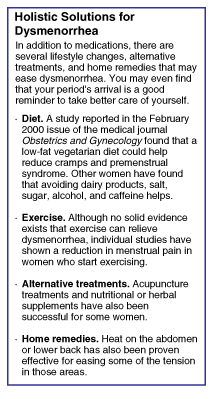Cramping Your Style: Dysmenorrhea Defined
It's hard to believe, but less than 20 years ago doctors often told women that their painful menstrual cramps were "all in their head." More than 50 percent of all women experience severe menstrual cramps, called dysmenorrhea. These days, not only is the condition acknowledged by the medical community, doctors are aware of two distinct types of dysmenorrhea -- primary and secondary -- for which there are many solutions available.
"The second time I got my period, I had really bad pain -- so bad that I could hardly walk," says Maria Budet, who began menstruating 17 years ago, when she was in fifth grade. "I was taken to the hospital because they thought I had appendicitis, but that was eventually ruled out. The doctor told me that my cramps were normal and that they were just part of being a woman."
The severity of menstrual cramps varies from woman to woman, and even from one period to the next in the same woman. Cramps can be as debilitating as those experienced by Budet or as mild as a slight twinge. Generally, however, dysmenorrhea causes any or all of the following symptoms: lower abdominal pain, backache, pain or spasms in the inner thighs and legs, nausea, vomiting, diarrhea, weakness, and chills. Dysmenorrhea is such a widespread condition, in fact, that is often cited as the most frequent cause of absenteeism from school among younger women.
"I hated getting my period," comments Budet. "Physically it took such an incredible toll on me that it affected my day-to-day activities. When I was in high school, I missed one day of school a month because of my cramps."
Primary vs. secondary dysmenorrhea: An important difference
Primary dysmenorrhea is, indeed, a common result of a woman's menses. Mechanically, menstrual cramps are similar to labor pains. The smooth muscles that make up the wall of the uterus contract to expel the lining of the uterus, dilating the cervix to allow for the passage of blood from the uterus to the vagina. These strong contractions are caused by prostaglandins, hormones produced by the body that are found in the uterine lining. Research shows that women with primary dysmenorrhea have a higher concentration of prostaglandins than women who experience only mild cramps or painless menstruation.
Secondary dysmenorrhea, which is more common in older women and in women who begin having menstrual cramps after the age of 25, has the same symptoms as primary dysmenorrhea but wholly different causes. The most common culprit is endometriosis, a condition that can lead to infertility by causing pelvic adhesions, abnormal ovulation, and the inability of the fallopian tube to support the egg. Other causes of secondary dysmenorrhea include polyps, pelvic inflammatory disease, infections, and the use of an IUD. If you are over 25 and have recently started experiencing menstrual cramps and heavy bleeding, have a thorough gynecological exam to determine whether a secondary condition may be causing the pain.
Relieving primary dysmenorrhea
Medicine has come a long way in its understanding of gynecological conditions. In the 1960s, your doctor might have told you to place a hot water bottle at your feet to draw the blood down. Nowadays, your doctor can prescribe medications as well as offer other suggestions for managing menstrual pain.

"I don't look at dysmenorrhea in terms of a cure," said Debra Gussman, M.D., of the obstetrics and gynecology department at the New York University School of Medicine. "You can cure someone of their menstrual problems, but that involves a hysterectomy. So the question I ask is, What are the best ways to block prostaglandins? There's a whole category of drugs called non-steroidal anti-inflammatories (NSAIDs). When taken at the right time, NSAIDS prevent your body from making prostaglandins." Over-the-counter NSAIDs include ibuprofen (Motrin, Advil) and naproxen (Alleve).
A gynecologist also may prescribe an oral contraceptive pill; for some women, being on the pill can produce milder, shorter menses, resulting in less cramping.
"Dysmenorrhea can be a horrible condition that really knocks people for a loop a couple of days a month," said Dr. Gussman. "But women are incredibly strong, and they learn to deal with all kinds of things."
Related link:
Outside link: Information on primary dysmenorrhea from the American Academy of Family Physicians
Send feedback on this article.

